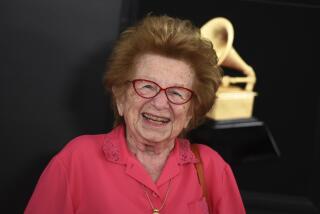The ‘Tastemaker’ paints Carl Van Vechten as cultural impressario of his time
Although he would hardly cause a blip on cultural radar screens today, Carl Van Vechten was, at various stages of his long and storied life, a journalist, provocateur, novelist, nightlife denizen, music and theater critic, confidant to Gertrude Stein, patron of the Harlem Renaissance, literary dandy, urban impresario, portrait photographer, archivist of Modernism and all-together man about town. A person of seemingly endless contradictions, Van Vechten was known for his many affairs with men — yet married to Fania Marinoff, a Russian actress and dancer, for almost 50 years.
In the first half of the 20th century, Van Vechten connected more cultural dots than any of his contemporaries, as Edward White points out in his fascinating and thoroughly researched new biography, “The Tastemaker: Carl Van Vechten and the Birth of Modern America.” Like many legendary New Yorkers, Van Vechten hailed from elsewhere; in his case, Cedar Rapids, Iowa, a progressive Midwestern farm town around the time he was born in 1880.
“His one burning desire,” White writes, “was to ditch the life of a bourgeois Midwesterner for the glamour and grime of the big cities.”
He did just that: first escaping to Chicago, where he discovered the burgeoning classical music and opera scenes fresh off the boat from Europe, as well as the African American communities of the South Side, which thrived during the early years of the 20th century because of the Great Migration north from the Jim Crow South. A few years after graduating from the University of Chicago, Van Vechten left for New York, where he would live until his death in 1964 at age 84.
“Through his life of indulgence and excess, and in promoting his bespoke pantheon of celebrities,” White writes in the prologue, “Van Vechten was one of the leading figures of a brash, iconoclastic generation of writers, artists and thinkers that helped Americans see that art and beauty existed amid the hum and buzz of their own cities and not just in the galleries and theaters of ancient European capitals. His life and legacy have been overlooked simply because of the extraordinary range of his interests.”
Van Vechten’s work as a cultural impresario took place, in many cases, at his own home. His apartment parties — most during the Prohibition years — were the stuff of legend: One night his guests might take in George Gershwin perfecting an early version of “Rhapsody in Blue” on the piano in the corner; on another night, they might be extolling the brilliance of Paul Robeson’s black spirituals or an impromptu performance by Bessie Smith.
His embrace and zealous promotion of the African American community — especially in the heyday of Harlem — is what he is most remembered for today, a point White expounds on throughout the second half of this biography, pulling from Van Vechten’s day book entries, as well as scores of letters and other correspondence he left behind. Not only did Van Vechten champion his African American friends to the white, upper crust of Manhattan, he helped such writers as Nella Larsen, Langston Hughes and Zora Neale Hurston (and later, Chester Himes and James Baldwin) find publishers for their work.
Van Vechten himself published seven novels, mostly semi-autobiographical satires of the cosmopolitan society he loved to skewer. His fascination with black Harlem, however, led him to write a realist novel “Nigger Heaven” — a slang term used by African Americans at the time to describe the nosebleed seats in the balcony of Harlem nightclubs — which caused a stir when it was first published and divided some within the African American community.
In his later years, having discovered the portable Leica camera in the early 1930s, he took up photography — portraiture in particular — as a serious art. Over the next 30 years, a coterie of who’s who would stop by his apartment studio and have their portraits taken. Despite creating an overwhelming amount of written and photographic output — all of which is at the special collections library at Yale and the New York Public Library — nearly all of Van Vechten’s novels, essays and photography collections are out of print, and his oeuvre has largely been forgotten. There is one recent readable but academic study of his life by scholar Emily Bernard, but in “The Tastemaker,” White delves deeper, producing a more nuanced portrait of Van Vechten’s life and times, as opposed to just his work and his relationships with major figures of the Harlem Renaissance.
“Far more lasting than his output of essays, books, and photography,” writes White, “was the example of the life he lived; no other man or woman before him embodied the vision of modern America. His urban odyssey made a virtue of racial and sexual diversity and collapsed the 19th Century distinctions between edifying art and facile entertainment, constantly probing the boundaries of what was considered good and bad taste.”
Van Vechten’s particular brand of narcissism might not be considered anything out of the ordinary in today’s social-network-obsessed, post-digital age. But with his oversized ego and knack for championing others’ work, he pushed the culture forward, regardless of his motivations.
“Though the world outside was changing as quickly now as when he first arrived in New York,” White writes in the closing pages of “The Tastemaker,” “inside the sanctity of his own apartment, Carl Van Vechten was still the only show in town.”
Gabel, as well as editing books, is the editor and associate publisher of the Pitchfork Review, as well as the editorial and creative director of the Chicagoan.
The Tastemaker
Carl Van Vechten and the Birth of Modern America
By Edward White
Farrar, Straus & Giroux, 352 pp, $30.00
More to Read
Sign up for our Book Club newsletter
Get the latest news, events and more from the Los Angeles Times Book Club, and help us get L.A. reading and talking.
You may occasionally receive promotional content from the Los Angeles Times.








